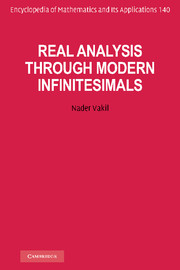Book contents
- Frontmatter
- Contents
- Preface
- Introduction
- PART I ELEMENTS OF REAL ANALYSIS
- 1 Internal set theory
- 2 The real number system
- 3 Sequences and series
- 4 The topology of ℝ
- 5 Limits and continuity
- 6 Differentiation
- 7 Integration
- 8 Sequences and series of functions
- 9 Infinite series
- PART II ELEMENTS OF ABSTRACT ANALYSIS
- Appendix A Vector spaces
- Appendix B The b-adic representation of numbers
- Appendix C Finite, denumerable, and uncountable sets
- Appendix D The syntax of mathematical languages
- References
- Index
2 - The real number system
from PART I - ELEMENTS OF REAL ANALYSIS
Published online by Cambridge University Press: 05 January 2013
- Frontmatter
- Contents
- Preface
- Introduction
- PART I ELEMENTS OF REAL ANALYSIS
- 1 Internal set theory
- 2 The real number system
- 3 Sequences and series
- 4 The topology of ℝ
- 5 Limits and continuity
- 6 Differentiation
- 7 Integration
- 8 Sequences and series of functions
- 9 Infinite series
- PART II ELEMENTS OF ABSTRACT ANALYSIS
- Appendix A Vector spaces
- Appendix B The b-adic representation of numbers
- Appendix C Finite, denumerable, and uncountable sets
- Appendix D The syntax of mathematical languages
- References
- Index
Summary
Introduction Traditional treatments of analysis are based on the ordinary real number system (R, +, ·, <), and their set-theoretical framework is ZFC. In this book, the set-theoretical framework is upgraded to IST and the real number system is upgraded to a system denoted by (ℝ, +, ·, <), where ℝ, +, ·, and < are standard sets in IST. It is useful to think of the system (ℝ, +, ·, <) as one to which the following informal remarks apply.
The properties of the elements of (ℝ, +, ·, <) are like the properties of the elements of anultrapower (*R, +, ·, <) of the ordinary real numbers, which we introduced in Definition 0.5.6.
The set ℝ, like *R, has both standard and nonstandard elements, and the standard elements of ℝ are none other than the ordinary real numbers. We shall use the symbols σℝ and R interchangeably to denote the class of the standard elements of ℝ. The presence of nonstandard numbers in ℝ endows the system (ℝ, +, ·, <) with external properties.
As far as the internal properties of the elements of (ℝ, +, ·, <) are concerned, the theory of (ℝ, +, ·, <) as an entity in IST is formally identical with the theory of (R, +, ·, <) as an entity in ZFC.
Information
- Type
- Chapter
- Information
- Real Analysis through Modern Infinitesimals , pp. 40 - 87Publisher: Cambridge University PressPrint publication year: 2011
